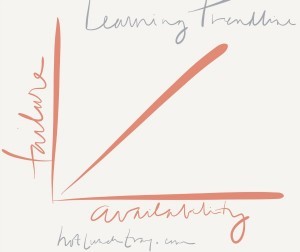Conventional wisdom dictates that some things cannot be rushed. In education, that often meant you needed to put in your years before you were wise. I would suggest that even though school years plod on at a consistent pace, your can increase the rate at which you learn – you can speed up your Learning Trendline.
Classrooms where a lesson happens once a year are the origins of this slow rate of teacher experience. How can the same lesson happen multiple times, with intentional variations, quickly to give feedback to educators? By building in the availability of that same/similar lesson into multiple places in the classroom lesson plan. Not that all students keep doing the same lesson, but that rounds of students encounter the same/similar lesson and in between those encounters the teacher crafts improvements to the lesson.

Everything looks pretty good in the plan book. But testing a lesson against a class is another matter, isn’t it? Sometimes even the best lessons go awry. What good teachers can do is adjust the lesson – both as it happens and then after the fact, planning for the next time the lesson is given. How can the perfecting of that lesson be hastened?
By making the lesson available multiple times in quick succession.
Making the lesson available more frequently tests the slight adjustments by the teacher. Giving multiple points of reference the teacher finds patterns emerge – what does and does not work – relatively fast and can make an adjustment to the plan book for next year in which s/he is more confident.
By the way – you are going to have more failures in a condensed period of time than other educators. Congratulations. Cycling through those lessons means more failure and that means more learning! You are amplifying the growth of your personal Learning Trendline.
Cycling through the same lesson in quick loops means not teaching whole group lessons, but chunking each class into groups to receive the lesson. In a Rotation model I would suggest a direct teaching component followed by an assessment component. If you plan to deliver the iterations of the lesson via flipped format just be certain to account for the availability of the recorded lesson to students.
This might be more appropriate in a face-to-face or blended classroom than an online classroom. If students were moving through at individual paces you could collect as many points of data as students. However, without a feedback checkpoint directly after the lesson and/or without knowing when students would attempt the lesson it might be less efficient.
Training teachers on technologies, I find the more groups of teachers, more frequently and closer together, the better for me. The more I am available the quicker I seem to cycle through questions, problems, and eventually solutions. I also have the added bonus of encountering more failures, more chances to model that adjustment process and I share how I will teach ‘my next group’ different. I am sometimes exhausted by this steep Learning Trendline – this is good news. This means the steeper my Learning Trendline, the faster I learn.






Leave a Reply